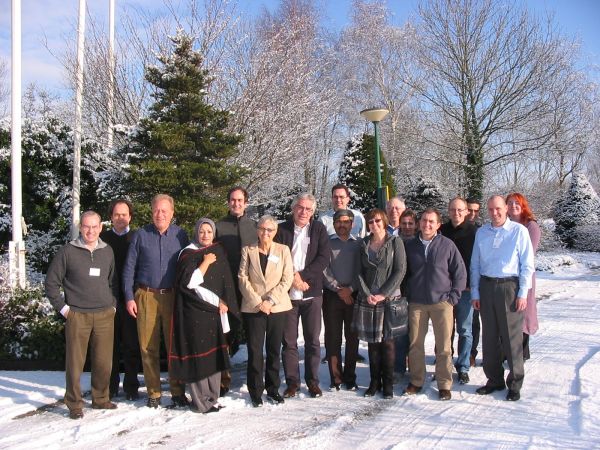Dysferlinopathy
- Number 172
- Date 31 January 2010
Location: Naarden, The Netherlands
Organisers : Kate Bushby, Isabel Illa, Martin Krahn, Nicolas Levy
The 172nd ENMC International workshop was dedicated to dysferlinopathies, a group of diseases due to mutations in dysferlin, the best known of which are limb-girdle muscular dystrophy 2B (LGMD2B) and Miyoshi Myopathy. In the past years, there has been increasing clinical interest in these conditions and the diagnosis is more readily available at least in some labs. The workshop was organized to consider how the diagnosis should be made, what we need to do to understand why the condition develops and work out what needs to be done to see possible therapies for these conditions developed. Seventeen international participants reviewed and discussed the current issues in the field of dysferlinopathies.
A first session dedicated to diagnostics, reviewed the current procedures and difficulties of dysferlin mutational analyses, and the importance of dysferlin protein testing on monocytes and/or muscle tissue in the diagnostic process. The discussions allowed the identification of central points to be included in a more formalized development of diagnostic guidelines, through the creation of an informal Network on Dysferlin Mutational Analysis. This session also included an overview on clinical and mutational data of a new gene Anoctamin 5 which has now been shown to cause a different condition which is very similar clinically to LGMD2B or MM but where dysferlin is normal. Finally, the importance of inflammatory features in dysferlin deficient muscle tissues from patients was outlined. The central importance of inflammation was subsequently largely developed in the sessions on animal and cellular models of dysferlinopathy, and novel insights into why there is such a prominent inflammatory infiltrate were presented. Major data on a novel muscle-specific dysferlin transgenic mouse model however indicate that the primary disease-causing event originates from the muscle tissue, and that the inflammatory events should therefore represent an aggravating cascade of secondary events. Working out exactly the way that dysferlinopathy happens at the cellular level will also require a better understanding of what proteins it interacts with which will need novel antibodies. All presentations and discussion further outlined the need for standardization of both animal and cellular models and the group was committed to working together to make this happen.
The final session was dedicated to therapeutic approaches. Preliminary data from the German trial on the use of corticosteroids in dysferlinopathies do not suggest any improvement in muscle strength, which is important data to be shared within the community towards avoiding steroids in proven dysferlinopathies in the future. Several innovative gene therapy (AAV gene transfer, mini-dysferlin, exon-skipping…) based strategies are currently under development. Finally, the central role of inflammation opens a novel field of possible pharmacological targets. A full report is published in Neuromuscular Disorders (pdf)
The workshop was concluded by a general discussion on efforts to be made towards harmonising registry development, and a planned Natural History Study as an essential step towards trial readiness in dysferlinopathies. A full report is published in Neuromuscular Disorders (pdf).

